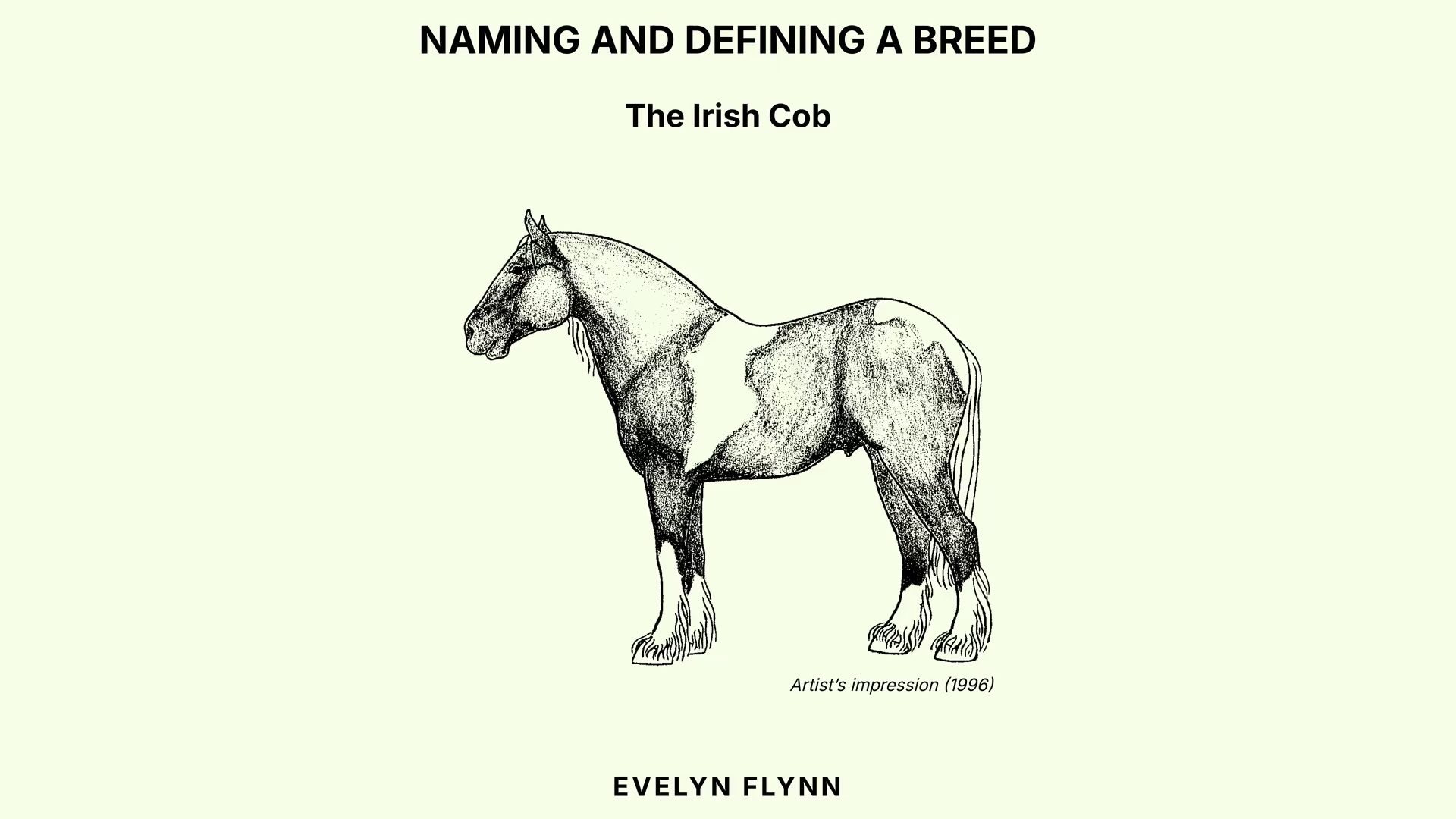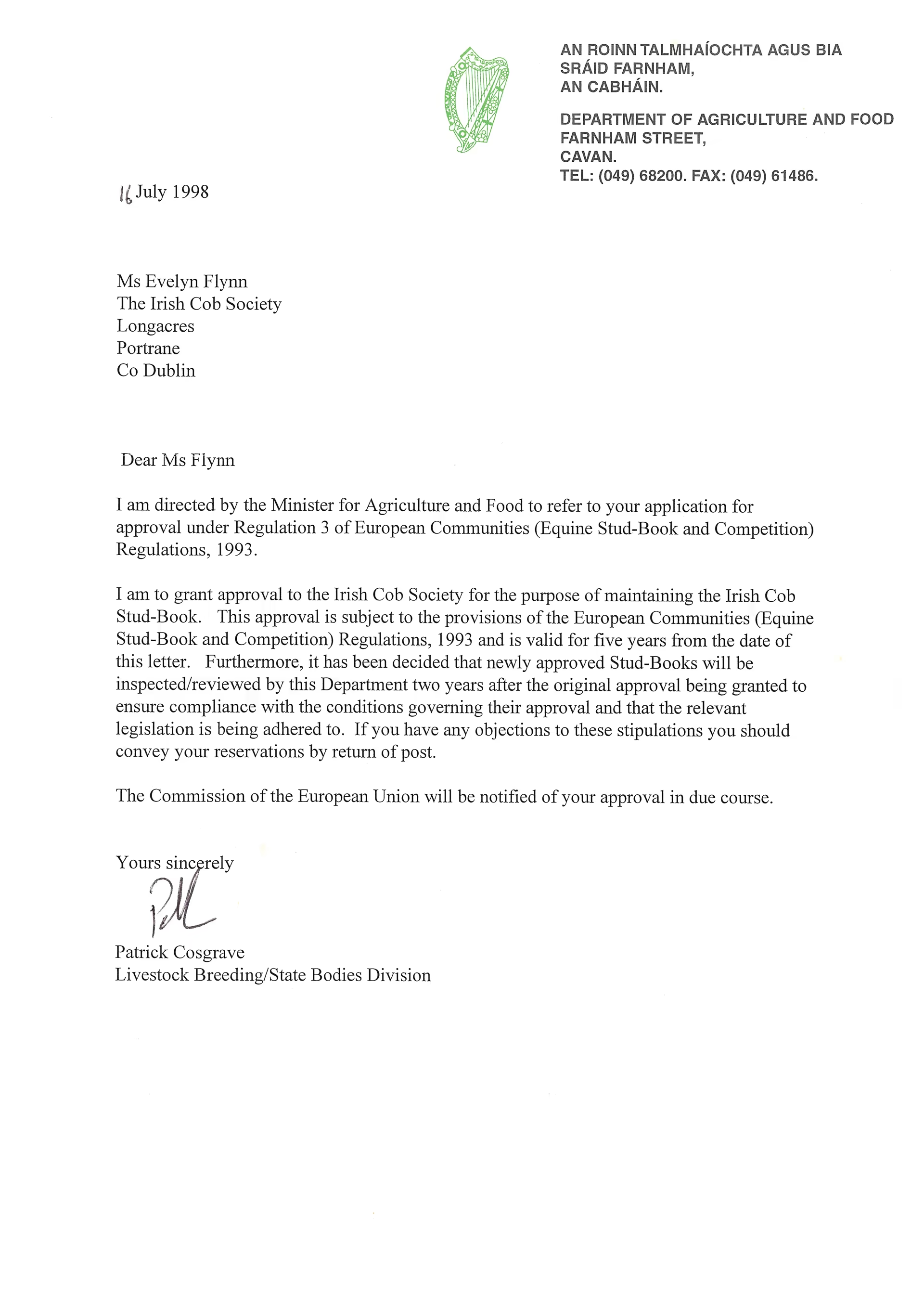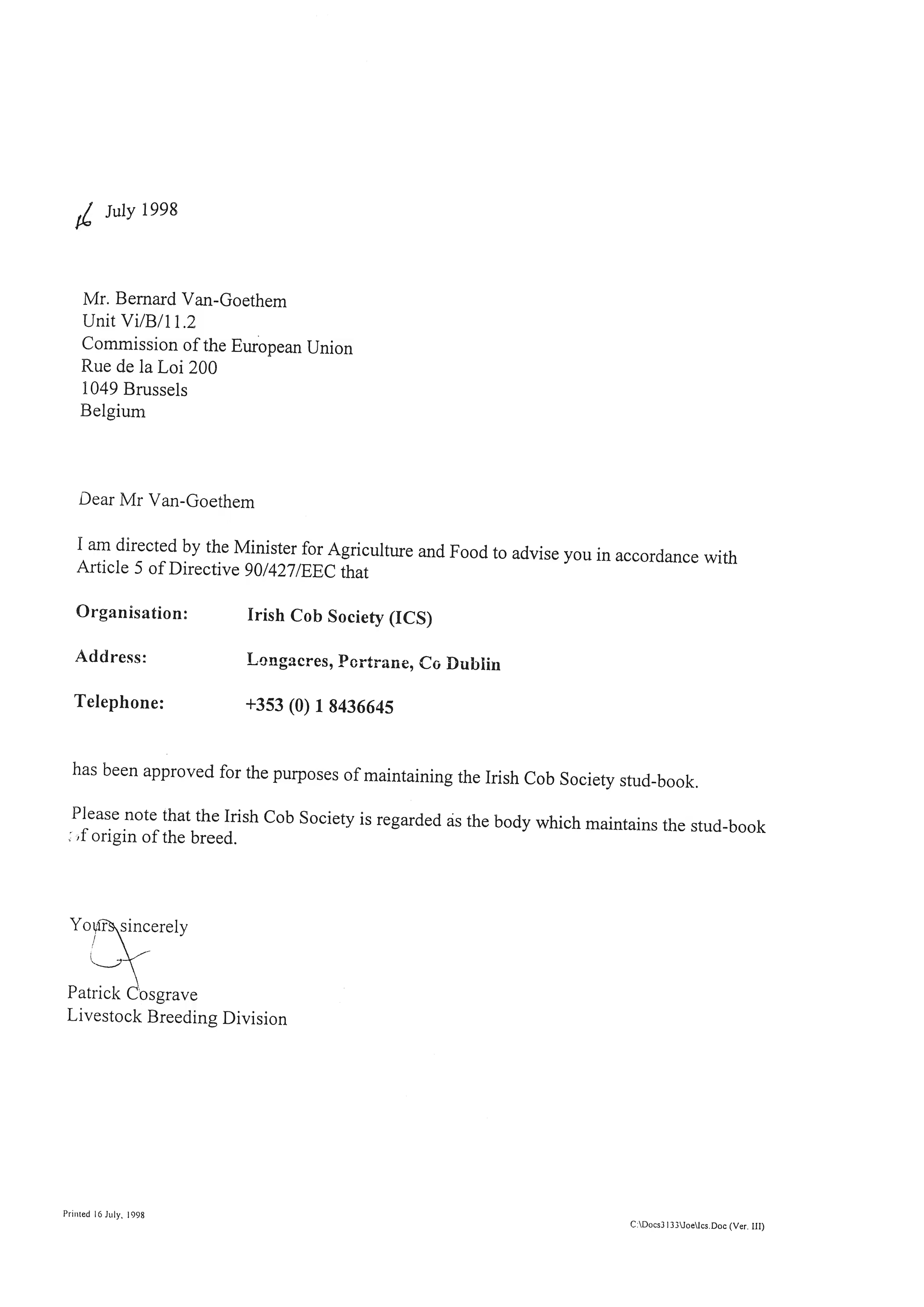
Naming and Defining a Breed – The Irish Cob
Published: Friday, 14th February 2025
My name is Evelyn Flynn, formerly Evelyn Murphy, and this is a personal account of my introduction to an extraordinary, unnamed horse breed in the early 1980s that led me to spend over ten years seeking to have the breed officially recognised in Ireland.
From 1981, I operated a horse trekking stables in North County Dublin in Ireland. Because most riders who came to the stables to go trekking were inexperienced and often nervous adults, I needed safe, hardy, kind and resilient horses that were cob sized (14hh to 15.3hh). So, I asked the stables horse supplier, Larry O’Connor (aka ‘Smithfield Larry’), if he could provide horses that would meet this criterion. One day, Larry called me and said he would drop off a cob to try out that he believed would suit the criteria for my trekking stables. I will always remember that day when Larry’s lorry drove into the yard. He pulled down the ramp of his lorry to reveal a very hairy-legged, dark bay chunk of a cob gelding that looked at me with a kind expression. I said, ‘But these cobs would not be the choice of riding stables’ and Larry replied, ‘Well, riding schools have discovered that there is no better or safer horse for their job’.
So, although I was smitten with the hairy-legged cob that came into my yard that day, I was uncertain about how my trekking clientele would receive him because he was an unrecorded and unrecognised breed that didn’t even have a breed name. However, I soon had an order in with Larry for more!
Unfortunately, due to a steep rise in commercial stable insurance, the trekking stables were forced to close in 1986. However, I continued my involvement with horses through the rest of the 1980s and into the 1990s by dabbling in horse breeding and trading, and my choice of horse breed choice was, of course, the unnamed Traditional Cob breed in Ireland developed by Irish Travellers that was to smitten me (and eventually the world) forever.
Naming and defining the breed (mid-1990s)
Because of the nomadic lifestyle of Irish Travellers and their prolific Traditional Cobs, the Irish countryside and cities were full of Ireland's unrecorded nomadic Traditional Cobs. As a result, the horse fairs in Ireland were filled with Traditional Cobs, which were predominantly piebald and therefore referred to by Irish Travellers as the Piebald. So, because I was fascinated with this unique and captivating unnamed breed, from the late 1980s to the early 1990’s I spent my time at horse fairs in Ireland (particularly the monthly Smithfield Horse Fair in Dublin and the annual Ballinasloe Horse Fair in Galway) and also at Irish Traveller camps where I studied the breed and took notes. However, from the beginning of the 1990s, I witnessed non-traveller horse traders from the United Kingdom and Holland coming to Ireland and filling their trucks, lorries and trailers with Traditional Cobs that they bought either at Irish horse fairs or directly from Irish Travellers. Because there was no studbook or register for Ireland’s unnamed Traditional Cob (and because Europe did not yet have an equine passport system), lorry loads of Ireland’s Traditional Cobs were exported from Ireland every week with no record of them ever having been in Ireland (or even having ever exited).
It is for this reason that I decided I needed to initiate the founding of a studbook for Ireland’s Traditional Cob. However, because a studbook is a breed standard with a breed name and with at least one qualified judge that can judge animals to conform to that breed standard, it meant that for me to initiate the founding of a studbook for Ireland’s Traditional Cob I would have to write the breed standard and therefore be the one qualified judge required to judge animals to conform to that breed standard (so that the studbook could be founded). So, I studied the breed intensively in the early 1990s until I was satisfied that I could define the characteristics of this unique breed and document them in a breed standard. Having documented the characteristics of the breed in a breed standard (breed description), I then had an artist draw their impression of the breed from my breed description, and based on the artist’s impression, I was satisfied that I had captured the essence of the breed in a breed standard. Now it was time to give a name to Ireland’s Traditional Cob. So, because Ireland is the country of origin of the breed, I documented the name Irish Cob by naming the breed standard the Irish Cob Breed Standard, and the name of the studbook would therefore be the Irish Cob Studbook.
Although I could have founded the Irish Cob Studbook on my own as an independent registry, because Ireland’s unnamed and unrecorded Traditional Cob had become one of the most sought-after horse breeds in Europe from the early 1990s, I aimed to have the Irish Cob officially recognised in Ireland as a national treasure and a valuable part of Ireland’s heritage and culture. However, the only way this could be done was to have the Irish Cob Studbook (and therefore the Irish Cob Breed Standard) officially recognised. In June 1996, I therefore made a call to the Department of Agriculture, Food and Forestry (DAFF) in Ireland, and I got to speak with Mr Brian Walsh. I told Mr Walsh about all the years of work and research I had done to write the Irish Cob Breed Standard and create the Irish Cob Studbook, and I explained to him why it was important to have the Irish Cob Studbook officially recognised in Ireland. Mr Walsh then explained that because passports are issued in respect of official (approved) studbooks, I would need to establish a body that could apply for registration as Keeper of the Irish Cob Studbook.
Mr Walsh suggested that I put my proposal in writing to the Department, which I did in a letter dated 28 June 1996. On 18 July 1996, Mr Walsh therefore issued a letter to me in which he stated, ‘I wish to acknowledge receipt of your letter dated 28 June 1996 concerning your proposal to establish a body and to apply to this Department for registration as Keeper of the Irish Cob Studbook’.
Because I had never before heard about horse passports, my idea to seek to have the Irish Cob Studbook made an official studbook was even more important for the breed than I had previously realised.

Official breed naming day: 18 July 1996
What I achieved on the 18 of July 1996 was to have an officially documented ‘naming day’ for Ireland's Traditional Cob, as well as an officially documented ‘recognition day’ for the Irish Cob Studbook (and therefore for the Irish Cob Breed Standard).
Application submitted in August 1996
In August 1996, I submitted an application to the Department seeking registration of my proposed Society, which I had named the Irish Cob Society, as Keeper of the Irish Cob Studbook. On 21 November 1996, the Department issued a letter acknowledging my application: 'I wish to acknowledge receipt of your application for registration as Keeper of the Irish Cob Studbook’.
The Irish Cob Studbook
On 16 July 1998, the Department official Mr Patrick Cosgrave issued a letter to The Irish Cob Society (ICS) advising me that he was to ‘grant approval to the Irish Cob Society for the purpose of maintaining the Irish Cob Studbook’.
Studbook of the origin of the breed
The Department official, Mr Patrick Cosgrave, also issued a letter to the Commission of the European Union on 16 July 1998 in which he notified the Commission that The Irish Cob Society (ICS) was regarded as the body which maintains the studbook of the origin of the breed (the mother Irish Cob Studbook).


PLEASE NOTE
Information and images removed from the blog update are being used in a new forthcoming TCR Blog titled ‘The Traditional Cobs of Ireland and the UK’ which will explain in detail the different between the Irish Cob and Gypsy Cob.
Last update: 24th April 2025

Evelyn Flynn
As author of The Irish Cob Breed Standard Evelyn was officially approved in Ireland as the first inspector and inspector trainer for the mother Irish Cob studbook which was officially founded in 1998. Up until 2012 Evelyn conducted numerous ICS Studbook inspections in Ireland and throughout Europe and also held seminars educating Irish Cob breeders and enthusiasts about the breed.